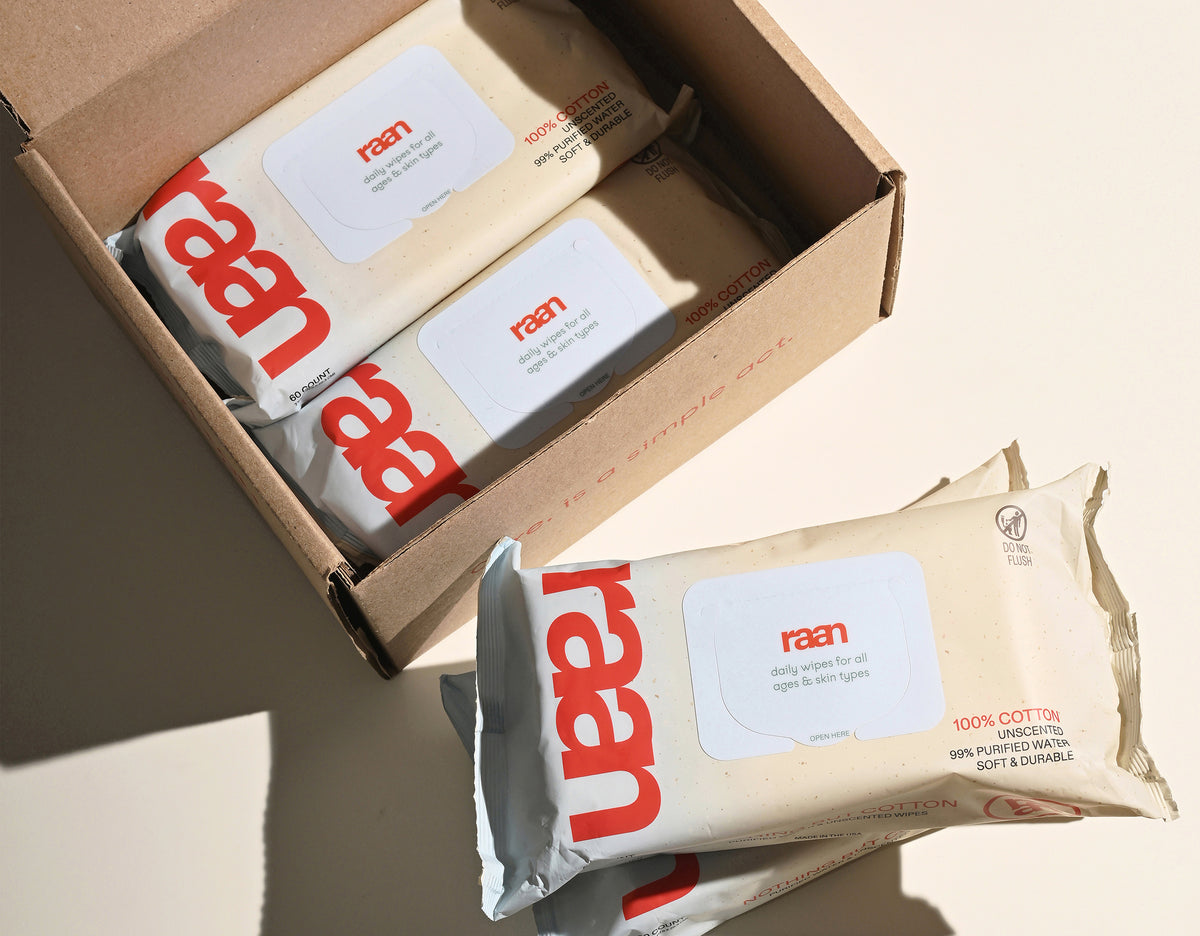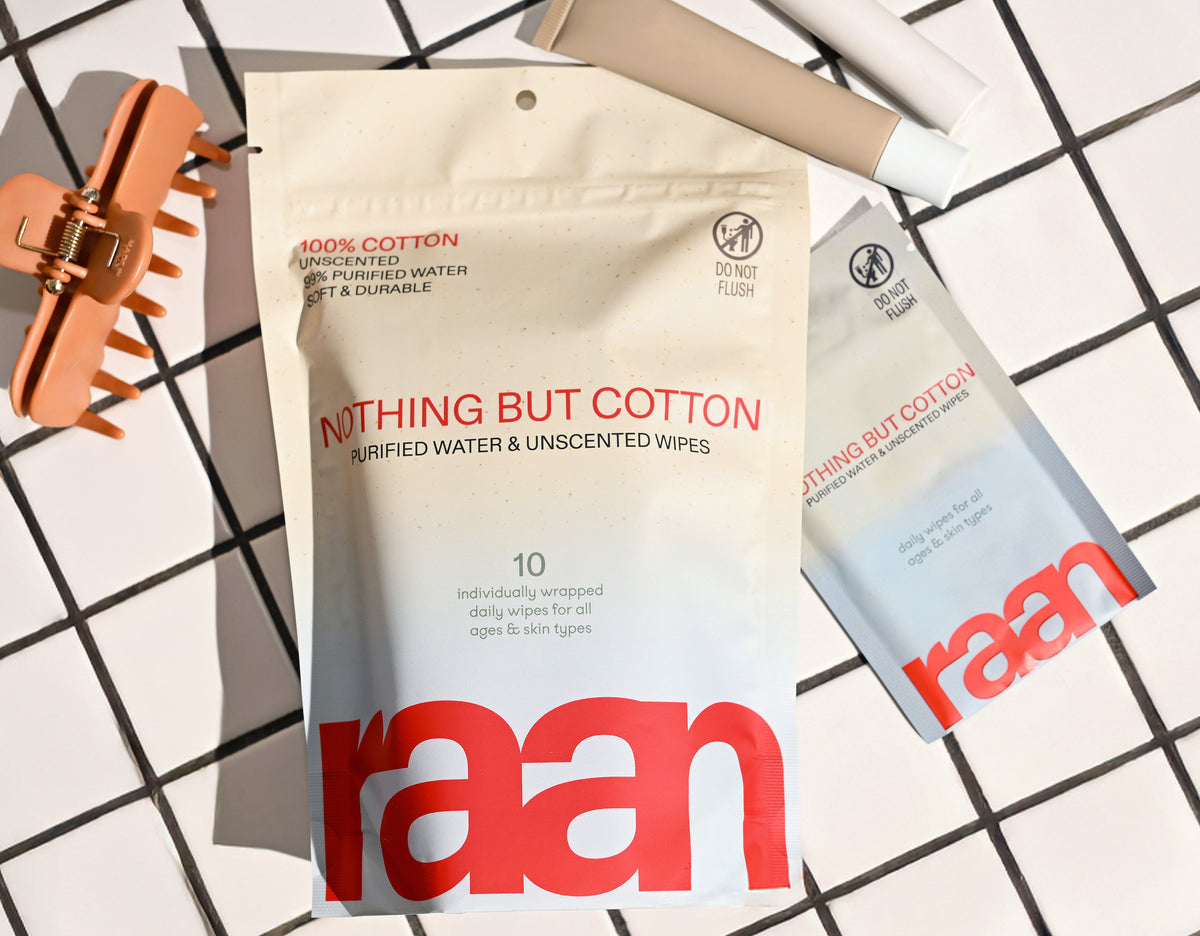Key Takeaways
- Wet Ones hand wipes use benzalkonium chloride as their main antibacterial ingredient.
- They contain synthetic moisturizers, preservatives, and fragrances.
- These wipes can kill 99.99% of germs within 15 seconds.
- The wipes are made with plastic fibers and synthetic ingredients.
- Some ingredients may cause irritation for people with sensitive skin.
Table of Contents
- What's Really Inside Wet Ones Hand Wipes
- Wet Ones vs. Hand Sanitizer: Physical Cleaning vs. Chemical Disinfection
- Better Options for Sensitive Skin: Why Cotton Matters
- Real-Life Applications: From Playground to Pet Care
- Environmental Impact: Plastic vs. Plant-Based Materials
- Choosing Wipes That Match Your Values
- Wet Ones vs. Hand Sanitizer Gel, What's the Difference and Which Is Best?
- Sensitive Skin? Comparing Wet Ones Sensitive Wipes and Raan Cotton Wipes
- Home, On-the-Go, For Everyone, Everyday Scenarios and Tips
- Beyond the Wipe, Packaging, Sustainability, and Care for the Planet
- Making the Informed Choice, What Truly Matters
- Most-Asked Questions, Quick Answers on Wet Ones Hand Wipes
- The New Standard: Why Raan Cotton Wipes Are Changing Everything
What's Really Inside Wet Ones Hand Wipes
Wet Ones hand wipes are designed for quick, on-the-go cleaning. Their main antibacterial ingredient is benzalkonium chloride, which targets common bacteria. Alongside this, the wipes contain synthetic moisturizers, preservatives, and fragrances to enhance feel and shelf life. The wipe material itself is made from plastic fibers, which do not break down naturally. For those with sensitive skin, some of these synthetic ingredients may cause irritation or dryness, especially with frequent use.
Wet Ones vs. Hand Sanitizer: Physical Cleaning vs. Chemical Disinfection

Unlike alcohol-based hand sanitizers that only kill germs, wet ones hand wipes physically remove dirt, sticky residue, and grime while disinfecting. This dual action makes them more effective for visibly dirty hands, think playground visits, snack time, or pet handling.
Hand sanitizer gels require clean hands to work effectively and can leave a sticky residue. Wipes tackle both cleaning and sanitizing in one step, making them practical for kids who touch everything and parents managing daily messes.
For families seeking a gentle, plant-based alternative to conventional wipes, the only unbleached, 100% cotton baby wipe for sensitive skin offers a safer option for newborns and those with allergies.
| Feature | Wet Ones Wipes | Hand Sanitizer Gel |
|---|---|---|
| Germ Killing | 99.99% in 15 seconds | 99.9% with 60%+ alcohol |
| Dirt Removal | Physical cleaning action | None |
| Portability | Bulkier packaging | Compact bottles |
| Skin Feel | May leave residue | Can be drying |
Better Options for Sensitive Skin: Why Cotton Matters
Conventional wet ones hand wipes use synthetic materials and preservatives that can trigger reactions in sensitive skin. For newborns, eczema-prone skin, or anyone avoiding synthetic ingredients, the material and formulation matter as much as the cleaning power.
Raan Cotton Wipes - Unbleached Simplicity
Best for: Sensitive skin, newborns, and anyone seeking transparent ingredients
Made from unbleached, 100% cotton with just five EWG-verified ingredients: purified water (99%), organic aloe, sodium benzoate, potassium sorbate, ethylhexylglycerin, and citric acid. No plastic fibers, synthetic fragrances, or bleaching chemicals.
The cotton material feels softer against skin and breaks down naturally, while food-grade preservatives ensure safety without synthetic additives. EWG Verified certification means every ingredient meets strict safety standards for daily use on the most delicate skin.
For on-the-go cleaning, unbleached, 100% cotton pocket wipe for sensitive skin is a convenient option for travel, gym bags, or lunchboxes.
Material Science: Plastic-fiber wipes can create micro-abrasions on sensitive skin. Cotton's natural texture provides gentle cleaning without irritation, making it safer for repeated use on faces and diaper areas.
Real-Life Applications: From Playground to Pet Care
Both wipe types excel in different scenarios. Wet ones hand wipes work well for quick sanitizing after public transport or shared surfaces. Their antibacterial action suits situations where germ-killing takes priority over ingredient gentleness.
For daily family use, diaper changes, face cleaning, food prep areas, cotton wipes offer versatility without synthetic exposure. Pet owners appreciate cotton's gentleness for paw cleaning, while skincare enthusiasts use them for makeup removal and gentle cleansing.
Storage matters for both: keep original packaging sealed, store below 80°F, and use within 60 days of opening. Neither type is flushable, despite common misconceptions.
Environmental Impact: Plastic vs. Plant-Based Materials

Standard wet ones hand wipes use plastic-fiber construction and rigid plastic packaging that contributes to landfill waste. The wipes don't biodegrade and require disposal in regular trash.
Cotton alternatives offer measurably less environmental impact: 70% less plastic packaging, 35% post-consumer waste content in pouches, and 100% recyclable boxes. The cotton material biodegrades naturally, though proper disposal in compost or trash remains important.
This difference matters for eco-conscious families making hundreds of wipe choices monthly. Small switches in daily essentials create meaningful cumulative impact.
If you're looking for a versatile, eco-friendly solution, the mess-ready pack is designed for families who want to reduce plastic waste without sacrificing cleaning power.
Choosing Wipes That Match Your Values
The best wipe depends on your priorities: immediate sanitization, ingredient transparency, skin sensitivity, or environmental impact. Wet ones hand wipes serve specific antibacterial needs but come with synthetic trade-offs.
For families prioritizing ingredient safety and skin gentleness, cotton wipes with EWG-verified formulations offer a simpler, more transparent alternative. Choosing wipes that align with your values means looking beyond marketing claims and focusing on what truly matters for your family and the planet.
Wet Ones vs. Hand Sanitizer Gel, What's the Difference and Which Is Best?
Hand wipes and sanitizer gels tackle different cleaning challenges. Wet ones hand wipes physically remove dirt, sticky residue, and grime while killing germs through benzalkonium chloride. Sanitizer gels rely on alcohol to disinfect but leave visible mess behind.
For families dealing with playground dirt, food spills, or pet-related cleanup, wipes offer superior mess removal. Gels work best for quick disinfection when hands appear clean but may have touched contaminated surfaces.
If you're assembling a complete cleaning kit for home or travel, the starter set provides a convenient way to try multiple cotton wipe options.
| Criteria | Hand Wipes | Sanitizer Gel |
|---|---|---|
| Germ Killing | 99.99% bacteria removal | 99.9% with 60%+ alcohol |
| Mess Removal | Removes dirt and residue | No cleaning action |
| Skin Feel | May leave slight moisture | Can feel sticky or dry |
| Portability | Bulkier packaging | Compact bottles |
Sensitive Skin? Comparing Wet Ones Sensitive Wipes and Raan Cotton Wipes

Wet Ones Sensitive claims hypoallergenic formulation and pediatrician testing, but ingredient transparency varies across product lines. Some variants contain synthetic preservatives and fragrance compounds that may irritate reactive skin.
Raan cotton wipes use five EWG-verified ingredients: 99% purified water, organic aloe, food-grade sodium benzoate and potassium sorbate, ethylhexylglycerin, and citric acid for pH balance. The unbleached, 100% cotton material contains no plastic fibers, synthetic fragrances, or harsh preservatives.
For newborn care and skincare-conscious users, the minimalist approach offers predictable gentleness. Wet ones hand wipes serve antibacterial needs effectively, while cotton alternatives prioritize ingredient safety and skin compatibility through radical transparency.
EWG Verification: Raan's ingredients meet Environmental Working Group's strictest safety standards, with full disclosure of every component and its purpose.
To learn more about ingredient differences and safety, see our in-depth guide on best cotton wipes.
Home, On-the-Go, For Everyone, Everyday Scenarios and Tips
Travel preparation requires moisture retention strategies. Store wet ones hand wipes in original packaging, seal tightly after each use, and consume within 60 days of opening. Individual packets work best for lunchboxes and gym bags where space matters.
New moms benefit from gentle formulations safe for diaper changes and face cleaning. Pet owners need quick cleanup solutions for post-walk paws and unexpected accidents. Skincare enthusiasts require wipes that won't disrupt their carefully curated routines.
Storage temperature affects longevity, keep wipes below 80°F and avoid direct sunlight. For extended freshness, flip canister packs periodically to redistribute moisture evenly throughout the stack.
For more tips on how many wipes you might need for your family, check out our article on how many wipes do I need.
Beyond the Wipe, Packaging, Sustainability, and Care for the Planet
Traditional wipe packaging relies heavily on rigid plastic containers and non-biodegradable materials. Wet ones hand wipes use standard industry packaging that prioritizes shelf stability over environmental impact.
Raan's approach reduces plastic waste by 70% through flexible pouch design with 35% post-consumer recycled content. The 100% recyclable outer boxes eliminate unnecessary hard plastic components while maintaining product integrity.
Neither option should be flushed, all personal care wipes belong in household trash regardless of marketing claims. The distinction lies in post-use environmental impact and packaging lifecycle considerations.
For more on the environmental impact of wipes, see this peer-reviewed study on wipes and sustainability.
Making the Informed Choice, What Truly Matters

Ingredient awareness drives better decisions. Look beyond marketing claims to actual formulation lists, seeking EWG verification, 100% cotton construction, and transparent preservation methods.
Wet ones hand wipes excel at antibacterial cleaning for active families managing daily messes. For sensitive skin priorities and minimalist ingredient preferences, unbleached cotton alternatives offer peace of mind through radical transparency.
Your choice depends on primary needs: immediate germ-killing effectiveness or long-term skin safety through simplified, food-grade formulations.
For a detailed breakdown of antibacterial ingredients and effectiveness, read our article on wet ones antibacterial hand wipes.
Most-Asked Questions, Quick Answers on Wet Ones Hand Wipes
Quick Answers: Essential facts about effectiveness, safety, and proper use for informed decisions.
Do Wet Ones kill 99.99% of germs as claimed? Yes, when used properly for the full 15-second contact time. The benzalkonium chloride formula targets common bacteria but isn't effective against all viruses or fungi. For more on hand hygiene and sanitizer use, see the CDC's official guidance on hand sanitizer.
Are they safe for facial use? Check specific product variants, some contain fragrances unsuitable for delicate facial skin. Unscented versions offer better compatibility for face cleaning.
How long do they stay effective? Unopened packages maintain potency for up to 2 years. Once opened, use within 30-60 days as moisture evaporation reduces cleaning effectiveness.
Can you travel with them? TSA allows wet ones hand wipes in carry-on luggage without liquid restrictions. Individual packets work best for air travel convenience.
Are they biodegradable or flushable? No to both. All personal care wipes belong in household trash regardless of material composition to prevent plumbing and environmental issues.
The New Standard: Why Raan Cotton Wipes Are Changing Everything
The billion-dollar wipes industry has operated on hidden plastics and mystery ingredients for decades. Raan disrupts this norm with radical transparency, five EWG-verified ingredients, unbleached 100% cotton, and zero synthetic preservatives.
This isn't just another baby wipe. It's a whole-family essential that elevates daily self-care routines through ingredient simplicity. Where conventional options rely on complex formulations, Raan proves that 99% purified water and organic aloe deliver superior gentleness without compromise.
The peace of mind comes from knowing exactly what touches your skin. No greenwashing, just green, with 70% less plastic packaging and 35% post-consumer recycled content. For new moms, skincare enthusiasts, and anyone prioritizing ingredient safety, this represents an easy upgrade to cleaner living.
Wet ones hand wipes serve their antibacterial purpose effectively, but the future belongs to transparency. When you can choose between mystery chemicals and food-grade ingredients, the decision becomes obvious.
The Bottom Line: Raan cotton wipes prove that effective cleaning doesn't require synthetic complexity, just honest ingredients and thoughtful design.
Frequently Asked Questions
What are the main antibacterial ingredients in Wet Ones hand wipes and how effective are they?
Wet Ones hand wipes use benzalkonium chloride as their main antibacterial ingredient, which can kill 99.99% of germs within 15 seconds. This ingredient targets common bacteria but is paired with synthetic moisturizers and preservatives to maintain the wipe's feel and shelf life.
How do Wet Ones hand wipes compare to hand sanitizer gels in terms of cleaning and disinfecting?
Wet Ones wipes physically remove dirt, sticky residue, and grime while disinfecting, making them effective for visibly dirty hands. Hand sanitizer gels primarily kill germs but don’t clean dirt and can leave a sticky or drying residue. Wipes offer a practical all-in-one solution for on-the-go messes.
Why might Wet Ones hand wipes cause irritation for people with sensitive skin, and what alternatives are recommended?
Wet Ones wipes contain synthetic preservatives, fragrances, and plastic fibers that can cause irritation or dryness, especially with frequent use on sensitive skin. A gentler alternative is unbleached, 100% cotton wipes with a minimalist, EWG-verified formula designed for sensitive skin and everyday use.
What are the environmental impacts of using Wet Ones wipes made from plastic fibers versus plant-based cotton wipes?
Wet Ones wipes are made with plastic fibers that do not break down naturally, contributing to plastic waste. In contrast, plant-based cotton wipes are unbleached, plastic-free, and biodegradable, offering a more sustainable option with packaging designed to reduce plastic use and support recycling.






